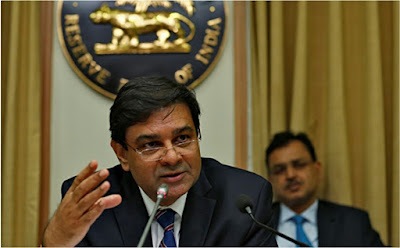Economic reforms is mainly dependent on the Fiscal and Monetary policies. Fiscal policy is regulated by the
Government of India and Monetary policy is regulated by the
RBI.
The six-member Monetary Policy Committee of
Reserve Bank of India on 5-Oct-2018, refrained from increasing the Repo Rate, the short term lending rate and kepy it unchanged. At present, the Repo Rate stands at 6.5 percent.
The policy-setting committee headed by Urjit Patel in its fourth Monetary Policy Committee meeting of FY19, opted to take a pause after hiking the rates in its last two successive policy meetings against the backdrop of the sharp depreciation in the rupee, rising crude oil prices, intense pressure on current account deficit (CAD) and liquidity issues.The monetary policy panel shifted its policy stance from ‘neutral‘ to ‘calibrated tightening‘. Five of the six members in the panel voted to leave the repo rate unchanged.
New Policy and Reserve Rates
Repo Rate : 6.5%
Reverse Repo Rate : 6.25%
CRR (Cash Reserve Ratio) : 4.00%
SLR (Statutory Liquidity Ratio) : 19.50%
MSF (Marginal Standing Facility) : 6.75%
Bank Rate : 6.75%
Important Highlights of RBI Monetary Policy
The following are the highlights of the fourth bi-monthly monetary policy statement for 2018-19 FY :
- RBI keeps the key lending Repo Rate unchanged at 6.5%
- Reverse repo rate stands at 6.25%, bank rate at 6.75%, CRR at 4%
- Projects retail inflation to rise to 3.8-4.5% in October-March
- Retains GDP growth estimate at 7.4% for the current fiscal FY19
- Global economic activities are becoming uneven, outlook clouded by uncertainties
- Excise cut in petrol and diesel will moderate the retail inflation.
- Rise in oil prices also, may have a bearing on the disposable incomes, as a result reducing the profit margins of corporates
- Oil prices remain vulnerable to further upside pressures
- Global and the domestic financial conditions are tightened,as a result may dampen investment activity
- Exports outlook uncertain
- Fiscal slippage at the centre or the state to have a bearing on the inflation outlook, besides heightening the market volatility and crowding out private investment
- Inflation outlook require a close vigil over the next few months,and thus several upside risks persist.
- Trade tensions, volatile and the rising oil prices, and also the tightening global financial conditions pose a substantial risks to growth,as per inflation outlook.
- Calls for further strengthening of the domestic macroeconomic fundamentals
- Next meeting of MPC will be on December 3-5, 2018
To Read More about the above mentioned information in detail :
Click HereRBI’s Monetary Policy
What is Monetary Policy ?
The policy made by the central bank (Reserve Bank of India) to control the money supply in the economy is known as Monetary Policy.
MPC (Monetary Policy Committee) : The Monetary Policy Committee of India is a committee of the Reserve Bank of India that is responsible for fixing the benchmark interest rate in India.
Section 45ZB of the amended RBI Act, 1934 provides for an empowered six-member monetary policy committee (MPC) to be constituted by the Central Government for determining the interest rates that are required to achieve the inflation target.
The MPC is required to do meeting at least four times in a year. Six membered Monetary Policy Committee is headed by RBI governor Urjit Patel.
The Members of the Monetary Policy Committee are appointed by the Central Government who holds office for a minimum period of four years.
Various tools/instruments of monetary policy
These instruments of Monetary Policy can be divided into quantitative and qualitative instruments.
Quantitative instruments
1. Open Market Operations (OMO)
This method refers to the buying and selling of securities, bills and bonds of government by RBI in the open market to expand or contract the amount of money in the banking system.
When the RBI purchases Government securities, liquidity is increased (because RBI is paying that party some money to buy that security or RBI is pouring additional money into the system).
On reverse, when the RBI sells Government securities, the liquidity decreases (because those players are giving their cash to RBI to purchase the securities.)
2. Liquidity Adjustment Facility(LAF)
Liquidity adjustment facilities (LAF) is also a tool used by the RBI to control short-term money supply. Liquidity adjustment facilities (LAF) has two tools or instruments namely Repo rate and Reverse Repo Rate.
Repo Rate: The interest rate at which the Reserve Bank provides loans to commercial banks against their dated government securities and treasury bills. Repo Rate is a short term measure.
Reverse Repo Rate: The interest rate at which the Reserve Bank of the country borrows from the commercial banks by mortgaging its dated government securities and treasury bills is known as Reverse Repo Rate.
While repo rate injects liquidity into the system, the Reverse repo rate absorbs liquidity from the system.
3. Marginal Standing Facility (MSF)
It is a loan facility for banks inorder to borrow from Reserve Bank of India in an emergency when inter-bank liquidity dries up completely.
How is MSF different from Repo rate?
MSF loan facility was created for the commercial banks to borrow from RBI in an emergency condition when inter-bank liquidity dries up and there is a volatility in the overnight interest rates. To curb this volatility, RBI has allowed them to deposit government securities and get more liquidity from the RBI at a rate higher than the Repo rate.
4. Reserve Ratio (SLR, CRR)
SLR (Statutory liquidity ratio): All commercial banks in the country are required to keep a given percentage of their demand and their time deposits (Net demand and time liabilities or NDTL) as liquid assets in their vault itself.
It prevents the bank from lending all of its deposits which is way too risky.
Note: Net Demand and Time Liabilities (NDTL) are mainly consist of Time liabilities and Demand liabilities.
Time liabilities includes:
- Money deposited in Fixed deposits (FD)
- Cash certificates
- Gold deposits etc.
Demand liabilities includes:
- Money deposited in savings account
- Money deposited in current account
- Demand drafts etc.
Cash Reserve Ratio (CRR): The Cash Reserve Ratio is the amount of funds that the banks are bound to park with Reserve bank of India as a certain percentage of their Net Demand and Time Liabilities (NDTL). Bank cannot lend it to anyone. Banks earns hardly any interest rate or profit on this.
What happens when CRR is reduced?
When CRR is reduced, this means that banks are required to keep fewer funds with RBI as the resources available to banks for lending will go up.
5. Bank Rate:
The bank rate is the rate which is fixed by the RBI, on which it re-discounts bills of exchange and government securities held by commercial banks.
It is also known as the discount rate.
Note: Bills of exchange– is a financial document that assures payment of money by the purchaser to the seller for goods purchased.
Differences between Repo rate and Bank rate: Repo Rate is a short-term measure, while on the other hand Bank Rate is a long-term measure.
Qualitative instruments
1. Credit rationing
In this instrument, RBI controls the maximum amount of credit flow to a certain sector.
RBI can also make it compulsory for the banks to provide a certain fractions of their loans to certain sectors such as priority sector lending etc.
2. Selective Credit control
Selective credit control is a tool controled by the Reserve Bank of India to restrict bank finance against sensitive commodities.
3. Margin Requirements
RBI can prescribe margin against collateral. For instance, lend only 70 Rs. for 100 Rs. value Property, margin requirement being 30%. If RBI raises the margin requirement, then customers will ultimately be able to borrow less.
4. Moral suasion
Moral Suasion refers to a method of request, a method of advice from the RBI to the commercial banks in taking certain measures as per the trend of the economy.
5. Direct Action
RBI issues certain guidelines from time to time based on the current situation in the economy. These guidelines should be followed by banks. In case,if any bank violates these guidelines, RBI penalizes them.
Please feel free to share this article with your near and dear ones, if you find it useful.
Thank you !!






Leave a Comment